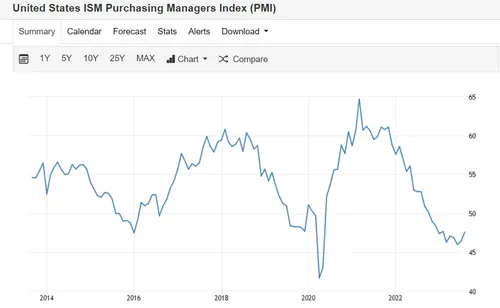Our partner, XM, lets you access a free demo account to apply your knowledge.
No hidden costs, no tricks.

Forex traders on the market need to consider a variety of factors when making trading decisions. The global economy is never stagnant and the markets reflect that. Due to an ever-changing economic landscape, traders need certain metrics to evaluate the health of the economy and make informed decisions.
One of such metrics is the Purchasing Managers’ Index, or PMI.
PMI measures the overall health of the manufacturing sector of the economy using different metrics that are surveyed and weighted to calculate the final PMI value.
Traders can use the metric to analyze changes in the manufacturing sector and its output to look for supply chain disruptions or other issues that may be hindering the sector.
PMI is especially important in forex trading and considering the index is essential in developing a viable strategy and achieving consistent success on the forex market.
If you are a beginner trader and would like to know more about the PMI and its effects on the forex market - this Investfox guide is for you.
The Purchasing Managers’ Index (PMI) is an economic indicator that provides valuable insight into the health and direction of a country's or region's manufacturing sector.
It is widely used by businesses, investors, and policymakers to assess the state of the economy and make informed decisions.

The PMI is based on a survey of purchasing managers in various industries. These managers are asked about various aspects of their business, such as new orders, production levels, employment, supplier deliveries, and inventory levels.
The survey responses are typically in the form of diffusion indices, which measure the percentage of respondents reporting improvements, no change, or declines in these factors compared to the previous month.
The PMI is calculated based on the survey results and each of the aspects are assigned a weight based on the results.
A reading above 50 generally indicates expansion in the manufacturing sector, while a reading below 50 suggests contraction.
The higher the PMI, the faster the expansions, and vice versa.
As already mentioned above, the PMI consists of several components that are weighted based on survey results, including:
The PMI value affects investors' confidence across the market, as a decline in manufacturing output can have ripple effects on the broader economy, which also adversely affects asset prices and the strength of currencies.
A high PMI can encourage businesses to invest in expanding production and hiring more workers, which strengthens the economy and the national currency.
Central banks may use PMI data as part of their decision-making process when setting interest rates.
PMI data is not limited to a single country; it can be used to assess the global economic situation by comparing PMI readings from different regions.
The main impact of the PMI on the forex market is on investor sentiment. If the sentiment is bullish, asset prices increase, and vice versa.
Our partner, XM, lets you access a free demo account to apply your knowledge.
No hidden costs, no tricks.
The PMI, or Purchasing Managers’ Index, is an index that measures the manufacturing sector of a target economy. Based on the PMI value, which is measured from 0 to 100, investors can estimate the strength of the national currency and make trades accordingly.
The higher the PMI value, the more robust the manufacturing sector becomes, which strengthens the local currency and affects its performance on the forex market.
PMI is calculated by weighting the five components of the index, which are: new orders, production, employment, supplier deliveries, and inventory levels.
Once the results have been weighted, a PMI value is derived, which ranges from 0 to 100.